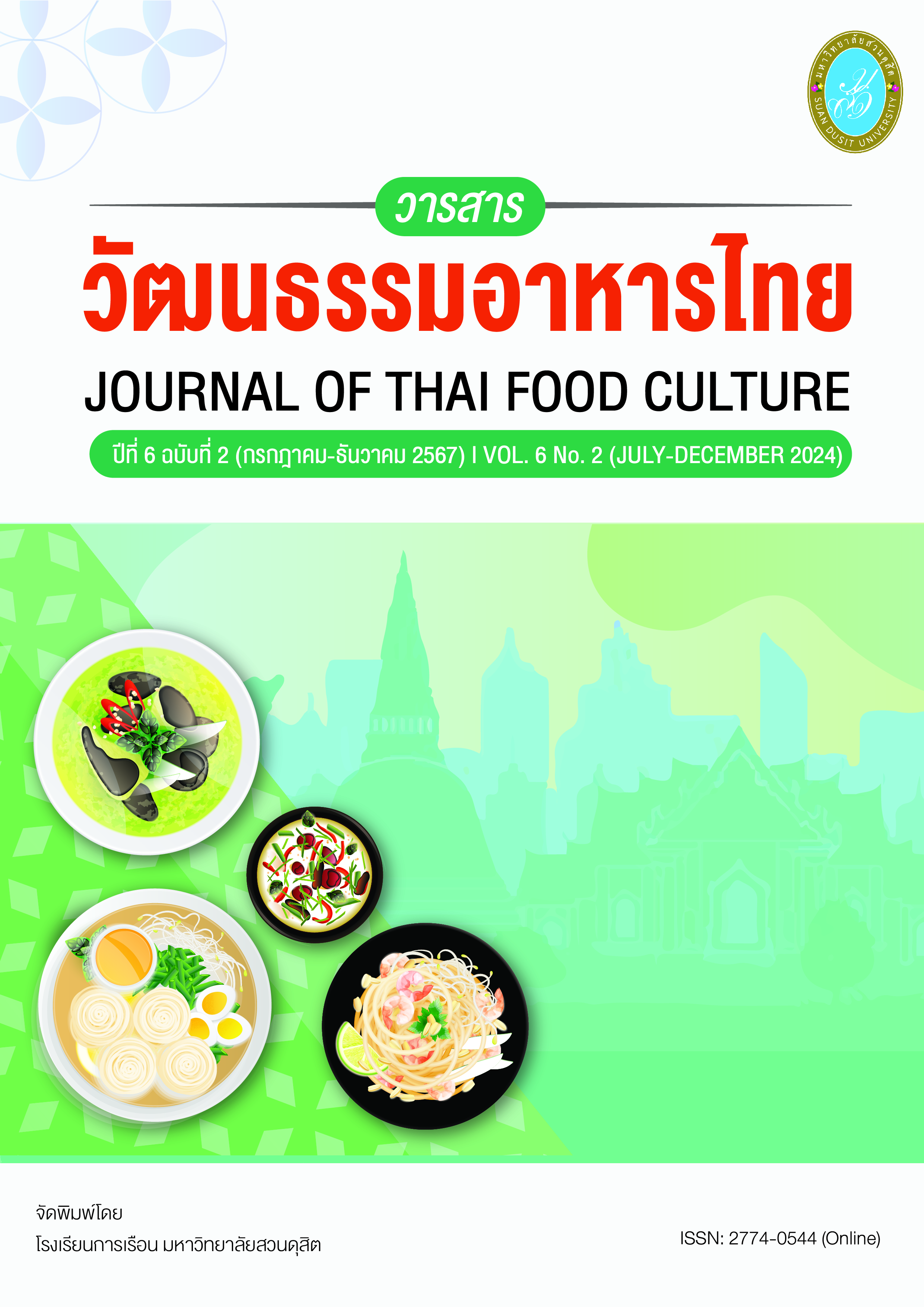The การพัฒนาผลิตภัณฑ์ขนมโกยเปตจากแป้งข้าวอัลฮัมดูลิลละห์
คำสำคัญ:
ข้าวพันธุ์อัลฮัมดูลิลละห์ ขนมโกยเปต ขนมทองพับบทคัดย่อ
การวิจัยครั้งนี้มีวัตถุประสงค์ เพื่อศึกษาสูตรมาตรฐานของขนมโกยเปต (ทองพับ) และ เพื่อศึกษาปริมาณอัตราส่วนแป้งข้าวอัลฮัมดูลิลละห์ที่ในผลิตภัณฑ์ขนมโกยเปต (ทองพับ) ที่เหมาะสม โดยผู้วิจัยศึกษาค้นคว้าสูตรขนมทองพับที่เป็นที่ยอมรับจำนวน 3 สูตร จากนั้นนำไปให้ผู้เชี่ยวชาญด้านอาหาร 5 ท่าน ทำการทดสอบโดยใช้แบบทดสอบคุณภาพทางประสาทสัมผัส 9 – point hedonic scale พบว่า สูตรที่ 3 ได้รับคะแนนความชอบจากผู้เชี่ยวชาญมากที่สุด โดยให้ระดับความชอบโดยรวมอยู่ในระดับ ชอบมาก (7.38) จากนั้นนำสูตรที่ 3 ไปพัฒนาผลิตภัณฑ์เป็นขนมโกยเปตจากแป้งข้าวอัลฮัมดูลิลละห์ โดยใช้แป้งข้าวข้าวอัลฮัมดูลิลละห์ทดแทนแป้งข้าวเจ้า 3 ระดับ คือ อัตราส่วนร้อยละ 30 50 และ 100 ของน้ำหนักแป้งข้าวเจ้าทั้งหมด ศึกษาคุณภาพทางประสาทสัมผัส และคุณภาพทางกายภาพของขนมโกยเปต พบว่าผู้ทำสอบคุณภาพทางประสาทสัมผัส จำนวน 50 คน พบว่าการใช้แป้งข้าวอัลฮัมดูลิลละห์ทดแทนแป้งข้าวเจ้า อัตราส่วน ร้อยละ 30 ของน้ำหนักแป้งข้าวเจ้า ได้รับการยอมรับสูงสุด อยู่ในระดับชอบมาก คะแนนความชอบโดยรวม (7.52) โดยมีความแตกต่างกันอย่างมีนัยสำคัญทางสถิติ (p≤0.05) การทดสอบคุณภาพด้านกายภาพด้านสี พบว่า การเพิ่มปริมาณแป้งข้าวอัลฮัมดูลิลละห์มากขึ้น ส่งผลให้ค่าความ สว่าง (L*) ค่าสีแดง (a*) และ ค่าสีเหลือง (b*) มากขึ้น ส่งผลให้ผลิตภัณฑ์มีสีเข้มขึ้น เช่นเดียวกับค่าความกรอบ Hardness (g Force) ที่เพิ่มสูงขึ้นเมื่อเพิ่มปริมาณแป้งข้าวอัลฮัมดูลิลละห์ อย่างมีนัยสำคัญทางสถิติ (p≤0.05) และพบว่าการใช้แป้งข้าวอัลฮัมดูลิลละห์ทดแป้งข้าวเจ้าที่อัตราส่วนร้อยละ 30 มีค่า Moisture และ ค่า Aw ต่ำที่สุด แต่ไม่มีความแตกต่างอย่างมีนัยสำคัญทางสถิติ (p≤0.05) กับอีกทั้ง 2 สูตร
เอกสารอ้างอิง
กรมอนามัย กระทรวงสาธารณสุข. (2530). ตารางแสดงคุณค่าทางโภชนาการของอาหารไทย. โรงพิมพ์องค์การทหารผ่านศึก, กรุงเทพฯ
กัลยา วานิชย์บัญชา. (2550). การใช้ SPSS for Windows ในการวิเคราะห์ข้อมูล. พิมพ์ครั้งที่ 10. กรุงเทพฯ : บริษัท ธรรมสาร จำกัด.
นวรัตน์ เอี่ยมพิทักษ์กิจ. (2550). ขนมอบ 2. พิมพ์ครั้งที่ 2. กรุงเทพฯ : สำนักพิมพ์ แสงแดด.
มัณฑนา นครเรียบ และไมตรี สุทธจิตต์. (2555). สารพฤกษเคมีในเมล็ดข้าวเหนียวดำและประโยชน์ที่ดีต่อสุขภาพ. วารสารนเรศวรพะเยา ปีที่ 5. ฉบับที่ 1. หน้า 28-35
เมวิกา ไร่รัตน์ และอภิญญา ชารีทา. (2556). การพัฒนาผลิตภัณฑ์ทองม้วนข้าวกล้องมันปูเสริมแก่นตะวัน. วิทยาศาสตรบัณฑิต สาขาวิชาเทคโนโลยีการอาหาร มหาวิทยาลัยราชภัฏมหาสารคาม
มูลนิธิสถาบันพัฒนามันสำปะหลังแห่งประเทศไทย ในพระราชูปถัมภ์สมเด็จพระเทพรัตนราชสุดาฯยามบรมราชกุมารี, มปป. https://tapiocathai.org/E5.html
ศิริลักษณ์ สินธวาลัย และ กมลวรรณ แจ้งชัด. 2544. วิทยาศาสตร์และเทคโนโลยีการทำขนมอบ เล่ม 1: วิทยาศาสตร์การทำขนมอบ. ภาควิชาพัฒนาผลิตภัณฑ์ คณะอุตสาหกรรมเกษตร มหาวิทยาลัยเกษตรศาสตร์, กรุงเทพฯ.
ศูนย์วิทยาศาสตร์ข้าว มหาวิทยาลัยเกษตรศาสตร์ “ข้าว” Source:https://dna.kps.ku.ac.th/index.php/research-develop/rice-research-and-knowledge/45-rice
สุทธิลักษณ์ ชีพสัตยากร. (2553). แผนธุรกิจ โดนิส เบเกอรี่. มหาบัณฑิต สาขาวิชาการประกอบการ คณะวิทยาการจัดการ มหาวิทยาลัยศิลปากร.
สุภาพ นนทะสันต์. (2553). การผลิตสีปรุงแต่งอาหารและสารเสริมสุขภาพจากรำข้าวเหนียวดำ. วิทยาศาสตรมหาบัณฑิต สาขาวิชาเทคโนโลยีการอาหาร มหาวิทยาลัยมหาสารคาม
สุนันท์ บุตรศาสตร์ สาริณี เสริมไธสง รุ่งทิพย์ เจริญมูล. (2561). การพัฒนาผลิตภัณฑ์ทองม้วนข้าวกล้องมันปูผสมแก่นตะวันเสริมสารสีจากพืช. วิทยาศาสตรบัณฑิต สาขาวิชาเทคโนโลยีการอาหาร มหาวิทยาลัยราชภัฏมหาสารคาม
อภิญญา ห่วงทอง. (2564). การพัฒนาผลิตภัณฑ์ขนมปังปราศจากกลูเตนจากแป้งข้าวบือซูโปะโละและแป้งข้าวบือซูโพปี้ต่อคุณภาพทางกายภาพและทางประสาทสัมผัสของผลิตภัณฑ์, มหาวิทยาลัยศิลปากร.
อรอนงค์ นัยวิกุล. (2547) ข้าว : วิทยาศาสตร์และเทคโนโลยี. กรุงเทพฯ : มหาวิทยาลัยเกษตรศาตร์,
อรอนงค์ นัยวิกุล. (2550). ข้าว. พิมพ์ครั้งที่ 2. กรุงเทพฯ : สำนักพิมพ์มหาวิทยาลัยเกษตรศาสตร์.
อุจิตชญา จิตรวิมล. (2551). วิทยาการประกอบอาหาร (Food Preparation Science). ศูนย์ปฏิบัติการพิมพ์ มหาวิทยาลัยเทคโนโลยีราชมงคลธัญบุรี, ปทุมธานี.
Boonsit, P., D. Karladee and P. Pongpiachan. Gamma Oryzanol Cotent in Purple RiceThailand local genotype, Agricultural Science. 337 : 191-194, 2006
David A. Mizer, Mary porter, Beth sonnier, Karen eich Drummond. 1999. Food Preparationfor the Professional. John Wiley & Sons’Inc, United States of America.
Duangmal, K., B. Saicheua and S. Sueeprasan. 2008. Colour Evaluation of Freeze-dried Roselle Extract as a Natural Food Folorant in a Model System of a Drink, Food Science and Technology, 41, pp. 1437-1445.
Qureshi, A., S. Sami and F. Khan. Effects of Sterbilized Rice Bran, Its Soluble and Fiber Fractions on Blood Glucose Levels and Serum Lipid Parameters in Humans with Diabetes Mellitus Types I and II, Nutritional Biochemistry. 13 : 175-187, 2002.
Rosso, V. and A. Mercardant. 2007. Evaluation of Colour and Stability of Anthocyanins from Tropical Fruits in an Isotonic Soft Drink System, Innovative Food Science and Emerging Technologies, 8, pp. 347-352. Marcel Dekker Inc. New York.
ดาวน์โหลด
เผยแพร่แล้ว
รูปแบบการอ้างอิง
ฉบับ
ประเภทบทความ
สัญญาอนุญาต
ลิขสิทธิ์ (c) 2025 โรงเรียนการเรือนสวนดุสิต

อนุญาตภายใต้เงื่อนไข Creative Commons Attribution-NonCommercial-NoDerivatives 4.0 International License.
ลิขสิทธิ์ต้นฉบับที่ได้รับการตีพิมพ์ในวารสารวัฒนธรรมอาหารไทย ถือเป็นกรรมสิทธิ์ของโรงเรียนการเรือน มหาวิทยาลัยสวนดุสิต ห้ามผู้ใดนำข้อความทั้งหมดหรือบางส่วนไปพิมพ์ซ้ำ เว้นแต่จะได้รับอนุญาตอย่างเป็นลายลักษณ์อักษรจากโรงเรียนการเรือน มหาวิทยาลัยสวนดุสิต นอกจากนี้ เนื้อหาที่ปรากฎในบทความเป็นความรับผิดชอบของผู้เขียน ทั้งนี้ไม่รวมความผิดพลาดอันเกิดจากเทคนิคการพิมพ์


